[English] 日本語
 Yorodumi
Yorodumi- PDB-6yan: Mammalian 48S late-stage translation initiation complex with hist... -
+ Open data
Open data
- Basic information
Basic information
| Entry | Database: PDB / ID: 6yan | |||||||||
|---|---|---|---|---|---|---|---|---|---|---|
| Title | Mammalian 48S late-stage translation initiation complex with histone 4 mRNA | |||||||||
 Components Components |
| |||||||||
 Keywords Keywords |  TRANSLATION / TRANSLATION /  initiation complex / 48S / eukaryotic initiation factor 1A / initiation complex / 48S / eukaryotic initiation factor 1A /  rabbit rabbit | |||||||||
| Function / homology |  Function and homology information Function and homology information ribosomal subunit / ribosomal subunit /  translation initiation factor activity / translation initiation factor activity /  DNA-(apurinic or apyrimidinic site) lyase / cytoplasmic stress granule / cytosolic small ribosomal subunit / small ribosomal subunit / DNA-(apurinic or apyrimidinic site) lyase / cytoplasmic stress granule / cytosolic small ribosomal subunit / small ribosomal subunit /  cell differentiation / cell differentiation /  ribosome / structural constituent of ribosome / ribosome / structural constituent of ribosome /  ribonucleoprotein complex ... ribonucleoprotein complex ... ribosomal subunit / ribosomal subunit /  translation initiation factor activity / translation initiation factor activity /  DNA-(apurinic or apyrimidinic site) lyase / cytoplasmic stress granule / cytosolic small ribosomal subunit / small ribosomal subunit / DNA-(apurinic or apyrimidinic site) lyase / cytoplasmic stress granule / cytosolic small ribosomal subunit / small ribosomal subunit /  cell differentiation / cell differentiation /  ribosome / structural constituent of ribosome / ribosome / structural constituent of ribosome /  ribonucleoprotein complex / ribonucleoprotein complex /  translation / translation /  nucleolus / nucleolus /  RNA binding / RNA binding /  cytoplasm cytoplasmSimilarity search - Function | |||||||||
| Biological species |   Oryctolagus cuniculus (rabbit) Oryctolagus cuniculus (rabbit)  Mus musculus (house mouse) Mus musculus (house mouse) | |||||||||
| Method |  ELECTRON MICROSCOPY / ELECTRON MICROSCOPY /  single particle reconstruction / single particle reconstruction /  cryo EM / Resolution: 3.48 Å cryo EM / Resolution: 3.48 Å | |||||||||
 Authors Authors | Bochler, A. / Simonetti, A. / Guca, E. / Hashem, Y. | |||||||||
| Funding support | European Union,  France, 2items France, 2items
| |||||||||
 Citation Citation |  Journal: Cell Rep / Year: 2020 Journal: Cell Rep / Year: 2020Title: Structural Insights into the Mammalian Late-Stage Initiation Complexes. Authors: Angelita Simonetti / Ewelina Guca / Anthony Bochler / Lauriane Kuhn / Yaser Hashem /  Abstract: In higher eukaryotes, the mRNA sequence in the direct vicinity of the start codon, called the Kozak sequence (CRCCaugG, where R is a purine), is known to influence the rate of the initiation process. ...In higher eukaryotes, the mRNA sequence in the direct vicinity of the start codon, called the Kozak sequence (CRCCaugG, where R is a purine), is known to influence the rate of the initiation process. However, the molecular basis underlying its role remains poorly understood. Here, we present the cryoelectron microscopy (cryo-EM) structures of mammalian late-stage 48S initiation complexes (LS48S ICs) in the presence of two different native mRNA sequences, β-globin and histone 4, at overall resolution of 3 and 3.5 Å, respectively. Our high-resolution structures unravel key interactions from the mRNA to eukaryotic initiation factors (eIFs): 1A, 2, 3, 18S rRNA, and several 40S ribosomal proteins. In addition, we are able to study the structural role of ABCE1 in the formation of native 48S ICs. Our results reveal a comprehensive map of ribosome/eIF-mRNA and ribosome/eIF-tRNA interactions and suggest the impact of mRNA sequence on the structure of the LS48S IC. | |||||||||
| History |
|
- Structure visualization
Structure visualization
| Movie |
 Movie viewer Movie viewer |
|---|---|
| Structure viewer | Molecule:  Molmil Molmil Jmol/JSmol Jmol/JSmol |
- Downloads & links
Downloads & links
- Download
Download
| PDBx/mmCIF format |  6yan.cif.gz 6yan.cif.gz | 1.8 MB | Display |  PDBx/mmCIF format PDBx/mmCIF format |
|---|---|---|---|---|
| PDB format |  pdb6yan.ent.gz pdb6yan.ent.gz | 1.4 MB | Display |  PDB format PDB format |
| PDBx/mmJSON format |  6yan.json.gz 6yan.json.gz | Tree view |  PDBx/mmJSON format PDBx/mmJSON format | |
| Others |  Other downloads Other downloads |
-Validation report
| Arichive directory |  https://data.pdbj.org/pub/pdb/validation_reports/ya/6yan https://data.pdbj.org/pub/pdb/validation_reports/ya/6yan ftp://data.pdbj.org/pub/pdb/validation_reports/ya/6yan ftp://data.pdbj.org/pub/pdb/validation_reports/ya/6yan | HTTPS FTP |
|---|
-Related structure data
| Related structure data |  10762MC  6yalC  6yamC C: citing same article ( M: map data used to model this data |
|---|---|
| Similar structure data |
- Links
Links
- Assembly
Assembly
| Deposited unit | 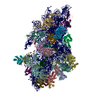
|
|---|---|
| 1 |
|
- Components
Components
-Protein/peptide , 1 types, 1 molecules l
| #1: Protein/peptide |  / eL41 / eL41Mass: 3473.451 Da / Num. of mol.: 1 / Source method: isolated from a natural source / Source: (natural)   Oryctolagus cuniculus (rabbit) / References: UniProt: A0A087WNH4 Oryctolagus cuniculus (rabbit) / References: UniProt: A0A087WNH4 |
|---|
-40S ribosomal protein ... , 16 types, 16 molecules CEGIKMOQVXZabciU
| #2: Protein |  / 37 kDa laminin receptor precursor / 37LRP / 37/67 kDa laminin receptor / LRP/LR / 67 kDa laminin ...37 kDa laminin receptor precursor / 37LRP / 37/67 kDa laminin receptor / LRP/LR / 67 kDa laminin receptor / 67LR / Laminin receptor 1 / LamR / Laminin-binding protein precursor p40 / LBP/p40 / 37 kDa laminin receptor precursor / 37LRP / 37/67 kDa laminin receptor / LRP/LR / 67 kDa laminin ...37 kDa laminin receptor precursor / 37LRP / 37/67 kDa laminin receptor / LRP/LR / 67 kDa laminin receptor / 67LR / Laminin receptor 1 / LamR / Laminin-binding protein precursor p40 / LBP/p40Mass: 23360.791 Da / Num. of mol.: 1 / Source method: isolated from a natural source / Source: (natural)   Oryctolagus cuniculus (rabbit) / References: UniProt: G1TLT8 Oryctolagus cuniculus (rabbit) / References: UniProt: G1TLT8 |
|---|---|
| #4: Protein |  Mass: 24814.285 Da / Num. of mol.: 1 / Source method: isolated from a natural source / Source: (natural)   Oryctolagus cuniculus (rabbit) / References: UniProt: G1TUT9*PLUS Oryctolagus cuniculus (rabbit) / References: UniProt: G1TUT9*PLUS |
| #6: Protein |  Mass: 29658.920 Da / Num. of mol.: 1 / Source method: isolated from a natural source / Source: (natural)   Oryctolagus cuniculus (rabbit) / References: UniProt: G1TK17 Oryctolagus cuniculus (rabbit) / References: UniProt: G1TK17 |
| #8: Protein |  Mass: 27471.535 Da / Num. of mol.: 1 / Source method: isolated from a natural source / Source: (natural)   Oryctolagus cuniculus (rabbit) / References: UniProt: G1TM55, UniProt: A0A5K1UJS7*PLUS Oryctolagus cuniculus (rabbit) / References: UniProt: G1TM55, UniProt: A0A5K1UJS7*PLUS |
| #10: Protein |  Mass: 23902.871 Da / Num. of mol.: 1 / Source method: isolated from a natural source / Source: (natural)   Oryctolagus cuniculus (rabbit) / References: UniProt: G1TJW1 Oryctolagus cuniculus (rabbit) / References: UniProt: G1TJW1 |
| #12: Protein |  Mass: 11773.953 Da / Num. of mol.: 1 / Source method: isolated from a natural source / Source: (natural)   Oryctolagus cuniculus (rabbit) / References: UniProt: G1TPV3 Oryctolagus cuniculus (rabbit) / References: UniProt: G1TPV3 |
| #14: Protein |  Mass: 13766.122 Da / Num. of mol.: 1 / Source method: isolated from a natural source / Source: (natural)   Oryctolagus cuniculus (rabbit) / References: UniProt: G1SFR8 Oryctolagus cuniculus (rabbit) / References: UniProt: G1SFR8 |
| #16: Protein |  Mass: 14544.659 Da / Num. of mol.: 1 / Source method: isolated from a natural source / Source: (natural)   Oryctolagus cuniculus (rabbit) / References: UniProt: G1T1F0 Oryctolagus cuniculus (rabbit) / References: UniProt: G1T1F0 |
| #19: Protein |  Mass: 15812.286 Da / Num. of mol.: 1 / Source method: isolated from a natural source / Source: (natural)   Oryctolagus cuniculus (rabbit) / References: UniProt: G1TN62 Oryctolagus cuniculus (rabbit) / References: UniProt: G1TN62 |
| #21: Protein |  Mass: 8896.102 Da / Num. of mol.: 1 / Source method: isolated from a natural source / Source: (natural)   Oryctolagus cuniculus (rabbit) / References: UniProt: G1TM82 Oryctolagus cuniculus (rabbit) / References: UniProt: G1TM82 |
| #23: Protein |  Mass: 15757.587 Da / Num. of mol.: 1 / Source method: isolated from a natural source / Source: (natural)   Oryctolagus cuniculus (rabbit) / References: UniProt: G1SZ47 Oryctolagus cuniculus (rabbit) / References: UniProt: G1SZ47 |
| #24: Protein |  Mass: 14575.199 Da / Num. of mol.: 1 / Source method: isolated from a natural source / Source: (natural)   Oryctolagus cuniculus (rabbit) / References: UniProt: G1TS40 Oryctolagus cuniculus (rabbit) / References: UniProt: G1TS40 |
| #25: Protein |  Mass: 11315.428 Da / Num. of mol.: 1 / Source method: isolated from a natural source / Source: (natural)   Oryctolagus cuniculus (rabbit) / References: UniProt: G1TFE8 Oryctolagus cuniculus (rabbit) / References: UniProt: G1TFE8 |
| #26: Protein |  Mass: 9480.186 Da / Num. of mol.: 1 / Source method: isolated from a natural source / Source: (natural)   Oryctolagus cuniculus (rabbit) / References: UniProt: G1TZ76 Oryctolagus cuniculus (rabbit) / References: UniProt: G1TZ76 |
| #32: Protein |  Mass: 6741.048 Da / Num. of mol.: 1 / Source method: isolated from a natural source / Source: (natural)   Oryctolagus cuniculus (rabbit) / References: UniProt: G1T8A2 Oryctolagus cuniculus (rabbit) / References: UniProt: G1T8A2 |
| #37: Protein |  Mass: 16642.307 Da / Num. of mol.: 1 / Source method: isolated from a natural source / Source: (natural)   Oryctolagus cuniculus (rabbit) / References: UniProt: G1TPG3 Oryctolagus cuniculus (rabbit) / References: UniProt: G1TPG3 |
-Ribosomal protein ... , 16 types, 16 molecules DFHJLNPSTYdefghR
| #3: Protein |  Mass: 24944.408 Da / Num. of mol.: 1 / Source method: isolated from a natural source / Source: (natural)   Oryctolagus cuniculus (rabbit) / References: UniProt: G1TN72 Oryctolagus cuniculus (rabbit) / References: UniProt: G1TN72 |
|---|---|
| #5: Protein |  Mass: 25158.535 Da / Num. of mol.: 1 / Source method: isolated from a natural source / Source: (natural)   Oryctolagus cuniculus (rabbit) / References: UniProt: G1TNM3 Oryctolagus cuniculus (rabbit) / References: UniProt: G1TNM3 |
| #7: Protein |  Mass: 21525.941 Da / Num. of mol.: 1 / Source method: isolated from a natural source / Source: (natural)   Oryctolagus cuniculus (rabbit) / References: UniProt: G1TFM5 Oryctolagus cuniculus (rabbit) / References: UniProt: G1TFM5 |
| #9: Protein |  Mass: 21716.387 Da / Num. of mol.: 1 / Source method: isolated from a natural source / Source: (natural)   Oryctolagus cuniculus (rabbit) / References: UniProt: G1SVB0 Oryctolagus cuniculus (rabbit) / References: UniProt: G1SVB0 |
| #11: Protein |  Ribosome RibosomeMass: 21266.166 Da / Num. of mol.: 1 / Source method: isolated from a natural source / Source: (natural)   Oryctolagus cuniculus (rabbit) / References: UniProt: B7NZS8 Oryctolagus cuniculus (rabbit) / References: UniProt: B7NZS8 |
| #13: Protein |  Mass: 18468.826 Da / Num. of mol.: 1 / Source method: isolated from a natural source / Source: (natural)   Oryctolagus cuniculus (rabbit) / References: UniProt: G1TRM4 Oryctolagus cuniculus (rabbit) / References: UniProt: G1TRM4 |
| #15: Protein |  Mass: 17128.191 Da / Num. of mol.: 1 / Source method: isolated from a natural source / Source: (natural)   Oryctolagus cuniculus (rabbit) / References: UniProt: G1SP51 Oryctolagus cuniculus (rabbit) / References: UniProt: G1SP51 |
| #17: Protein |  Mass: 15975.753 Da / Num. of mol.: 1 / Source method: isolated from a natural source / Source: (natural)   Oryctolagus cuniculus (rabbit) / References: UniProt: G1SGX4 Oryctolagus cuniculus (rabbit) / References: UniProt: G1SGX4 |
| #18: Protein |  Mass: 14578.988 Da / Num. of mol.: 1 / Source method: isolated from a natural source / Source: (natural)   Oryctolagus cuniculus (rabbit) / References: UniProt: G1TU13 Oryctolagus cuniculus (rabbit) / References: UniProt: G1TU13 |
| #22: Protein |  Ribosome RibosomeMass: 14734.357 Da / Num. of mol.: 1 / Source method: isolated from a natural source / Source: (natural)   Oryctolagus cuniculus (rabbit) / References: UniProt: G1TG89 Oryctolagus cuniculus (rabbit) / References: UniProt: G1TG89 |
| #27: Protein |  Mass: 7263.394 Da / Num. of mol.: 1 / Source method: isolated from a natural source / Source: (natural)   Oryctolagus cuniculus (rabbit) / References: UniProt: G1TIB4 Oryctolagus cuniculus (rabbit) / References: UniProt: G1TIB4 |
| #28: Protein |  Mass: 6364.426 Da / Num. of mol.: 1 / Source method: isolated from a natural source / Source: (natural)   Oryctolagus cuniculus (rabbit) / References: UniProt: G1U7M4 Oryctolagus cuniculus (rabbit) / References: UniProt: G1U7M4 |
| #29: Protein |  Mass: 8358.903 Da / Num. of mol.: 1 / Source method: isolated from a natural source / Source: (natural)   Oryctolagus cuniculus (rabbit) / References: UniProt: G1SK22 Oryctolagus cuniculus (rabbit) / References: UniProt: G1SK22 |
| #30: Protein |  Mass: 34669.113 Da / Num. of mol.: 1 / Source method: isolated from a natural source / Source: (natural)   Oryctolagus cuniculus (rabbit) / References: UniProt: G1SJB4 Oryctolagus cuniculus (rabbit) / References: UniProt: G1SJB4 |
| #31: Protein |  Mass: 8526.119 Da / Num. of mol.: 1 / Source method: isolated from a natural source / Source: (natural)   Oryctolagus cuniculus (rabbit) / References: UniProt: G1TDB3 Oryctolagus cuniculus (rabbit) / References: UniProt: G1TDB3 |
| #38: Protein |  Mass: 15873.732 Da / Num. of mol.: 1 / Source method: isolated from a natural source / Source: (natural)   Oryctolagus cuniculus (rabbit) / References: UniProt: G1U0Q2 Oryctolagus cuniculus (rabbit) / References: UniProt: G1U0Q2 |
-Protein , 3 types, 3 molecules WAB
| #20: Protein | Mass: 11765.890 Da / Num. of mol.: 1 / Source method: isolated from a natural source / Source: (natural)   Oryctolagus cuniculus (rabbit) / References: UniProt: A0A5F9CX53, UniProt: G1SIZ2*PLUS Oryctolagus cuniculus (rabbit) / References: UniProt: A0A5F9CX53, UniProt: G1SIZ2*PLUS |
|---|---|
| #35: Protein | Mass: 30633.297 Da / Num. of mol.: 1 / Source method: isolated from a natural source / Source: (natural)   Oryctolagus cuniculus (rabbit) / References: UniProt: G1T2G4 Oryctolagus cuniculus (rabbit) / References: UniProt: G1T2G4 |
| #36: Protein | Mass: 45862.441 Da / Num. of mol.: 1 / Source method: isolated from a natural source / Source: (natural)   Oryctolagus cuniculus (rabbit) Oryctolagus cuniculus (rabbit) |
-RNA chain , 3 types, 3 molecules 231
| #33: RNA chain |  Mass: 601015.688 Da / Num. of mol.: 1 / Source method: isolated from a natural source / Details: U at position 1244 is modified / Source: (natural)   Oryctolagus cuniculus (rabbit) Oryctolagus cuniculus (rabbit) |
|---|---|
| #34: RNA chain | Mass: 11685.985 Da / Num. of mol.: 1 / Source method: obtained synthetically / Source: (synth.)   Mus musculus (house mouse) Mus musculus (house mouse) |
| #39: RNA chain | Mass: 24376.625 Da / Num. of mol.: 1 / Source method: isolated from a natural source Details: adenine at position 37 is modified (threonyl-carbomoyl-adenosine (t6A)) Source: (natural)   Oryctolagus cuniculus (rabbit) Oryctolagus cuniculus (rabbit) |
-Details
| Has ligand of interest | N |
|---|
-Experimental details
-Experiment
| Experiment | Method:  ELECTRON MICROSCOPY ELECTRON MICROSCOPY |
|---|---|
| EM experiment | Aggregation state: PARTICLE / 3D reconstruction method:  single particle reconstruction single particle reconstruction |
- Sample preparation
Sample preparation
| Component |
| ||||||||||||||||||||||||
|---|---|---|---|---|---|---|---|---|---|---|---|---|---|---|---|---|---|---|---|---|---|---|---|---|---|
| Source (natural) |
| ||||||||||||||||||||||||
| Source (recombinant) | Organism: synthetic construct (others) | ||||||||||||||||||||||||
| Buffer solution | pH: 7.4 | ||||||||||||||||||||||||
| Specimen | Embedding applied: NO / Shadowing applied: NO / Staining applied : NO / Vitrification applied : NO / Vitrification applied : YES : YES | ||||||||||||||||||||||||
Vitrification | Cryogen name: ETHANE |
- Electron microscopy imaging
Electron microscopy imaging
| Experimental equipment |  Model: Titan Krios / Image courtesy: FEI Company |
|---|---|
| Microscopy | Model: FEI TITAN KRIOS |
| Electron gun | Electron source : :  FIELD EMISSION GUN / Accelerating voltage: 300 kV / Illumination mode: FLOOD BEAM FIELD EMISSION GUN / Accelerating voltage: 300 kV / Illumination mode: FLOOD BEAM |
| Electron lens | Mode: BRIGHT FIELD Bright-field microscopy Bright-field microscopy |
| Image recording | Electron dose: 26 e/Å2 / Detector mode: SUPER-RESOLUTION / Film or detector model: GATAN K2 SUMMIT (4k x 4k) |
- Processing
Processing
CTF correction | Type: NONE |
|---|---|
3D reconstruction | Resolution: 3.48 Å / Resolution method: FSC 0.143 CUT-OFF / Num. of particles: 372000 / Symmetry type: POINT |
| Atomic model building | Protocol: FLEXIBLE FIT |
 Movie
Movie Controller
Controller






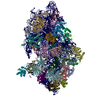



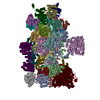
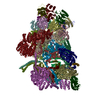
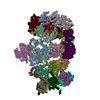

 PDBj
PDBj
































